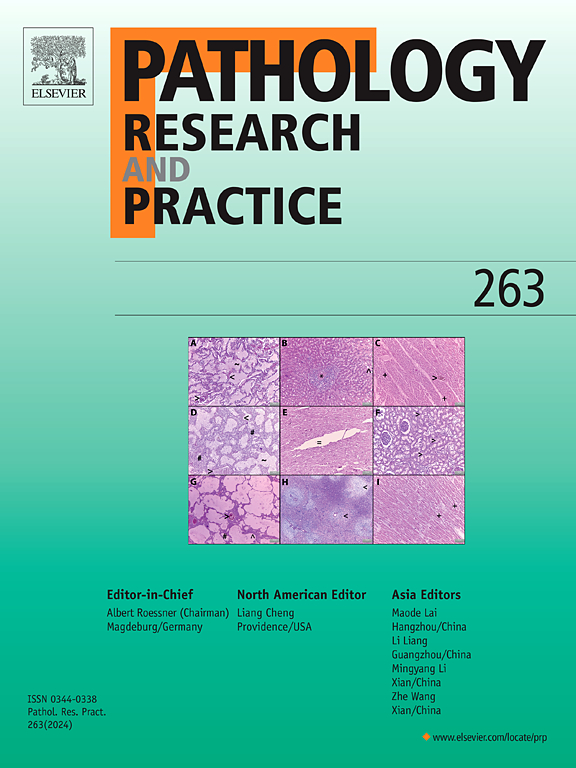Expression of claudin 18.2 in poorly cohesive carcinoma and its association with clinicopathologic parameters in East Asian patients
IF 2.9
4区 医学
Q2 PATHOLOGY
引用次数: 0
Abstract
Background
Poorly cohesive carcinoma (PCC) is a distinct subtype of gastric cancer with limited therapeutic options. This study investigated claudin (CLDN) 18.2 expression status in PCCs using a 43–13 A clone.
Methods
We retrospectively collected 178 consecutive surgically resected stage Ⅱ–Ⅲ gastric cancer samples. Tissue microarray blocks were constructed for CLDN18.2 immunohistochemical staining. We studied CLDN18.2 expression and its association with clinicopathologic parameters.
Results
CLDN18.2 positivity (defined by ≥ 75 % of tumor cells showing moderate to strong membranous positivity) was found in 34.8 % of the PCC cases (62/178). Approximately half of the CLDN18.2 positive PCCs demonstrated heterogeneous expression (51.6 %, 32/62). CLDN18.2 positivity was not associated with any clinicopathologic parameters examined. However, CLDN18.2 positivity tended to be more frequent in E-cadherin-positive PCCs (no loss of expression) than in E-cadherin-negative PCCs (loss of expression) (50 % vs. 27.7 %). The CLDN18.2 expression level, represented by the H-score, gradually decreased as the paraffin block storage time increased (P = 0.046). Overall survival and disease-free survival analyses showed no significant difference between CLDN18.2-positive and negative PCCs.
Conclusions
A significant portion of surgically resected PCC specimens showed CLDN18.2 positivity. Additionally, since the expression level of CLDN18.2 gradually decreases with increased paraffin block storage time, reflex testing can be considered at the time of the cancer diagnosis.
东亚贫粘连癌中 claudin 18.2 的表达及其与临床病理参数的关系。
背景:粘连性差的胃癌(PCC)是胃癌的一个独特亚型,治疗方案有限。本研究利用 43-13 A 克隆研究了 PCC 中 claudin(CLDN)18.2 的表达状况:方法:我们回顾性收集了 178 例连续手术切除的Ⅱ-Ⅲ期胃癌样本。方法:我们回顾性地收集了 178 例手术切除的Ⅱ-Ⅲ期胃癌样本,并构建了组织微阵列块进行 CLDN18.2 免疫组化染色。我们研究了CLDN18.2的表达及其与临床病理参数的关系:34.8%的PCC病例(62/178)发现了CLDN18.2阳性(定义为≥75%的肿瘤细胞显示中度至高度膜阳性)。约有一半的 CLDN18.2 阳性 PCC 呈异质性表达(51.6%,32/62)。CLDN18.2 阳性与任何临床病理参数均无关联。不过,CLDN18.2阳性在E-cadherin阳性PCC(无表达缺失)中的出现率往往高于E-cadherin阴性PCC(表达缺失)(50%对27.7%)。随着石蜡块储存时间的延长,以H-评分表示的CLDN18.2表达水平逐渐降低(P = 0.046)。总生存期和无病生存期分析表明,CLDN18.2阳性和阴性PCC之间无明显差异:结论:相当一部分手术切除的PCC标本显示CLDN18.2阳性。此外,由于 CLDN18.2 的表达水平会随着石蜡块储存时间的延长而逐渐降低,因此在诊断癌症时可考虑进行反射检测。
本文章由计算机程序翻译,如有差异,请以英文原文为准。
求助全文
约1分钟内获得全文
求助全文
来源期刊
CiteScore
5.00
自引率
3.60%
发文量
405
审稿时长
24 days
期刊介绍:
Pathology, Research and Practice provides accessible coverage of the most recent developments across the entire field of pathology: Reviews focus on recent progress in pathology, while Comments look at interesting current problems and at hypotheses for future developments in pathology. Original Papers present novel findings on all aspects of general, anatomic and molecular pathology. Rapid Communications inform readers on preliminary findings that may be relevant for further studies and need to be communicated quickly. Teaching Cases look at new aspects or special diagnostic problems of diseases and at case reports relevant for the pathologist''s practice.

 求助内容:
求助内容: 应助结果提醒方式:
应助结果提醒方式:


